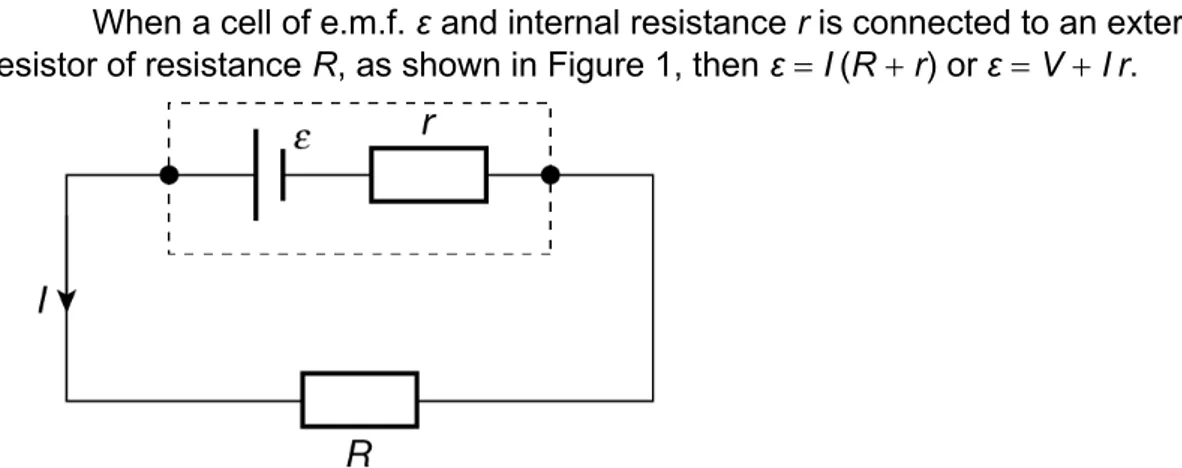Cells, electromotive force, and internal
resistance
Specification references
4.3.1 a) b) c) d) e) f) 4.3.2 a) b) c) (i)
M0.1
M1.1
M2.2, M2.3
Introduction
This worksheet builds on ‘10 Support: Kirchhoff’s laws and combining resistors’. You will learn to use two new methods for calculating power, and how to solve problems about electromotive force (e.m.f.) and internal resistance.
Learning outcomes
After completing the worksheet you should be able to:
explain why the potential difference (p.d.) of a battery (or cell) in use is less than its e.m.f.
solve circuit problems involving e.m.f. and internal resistance
use the equations PI2 R and P to calculate power dissipated.
Background
The e.m.f. of a battery (or cell), ε, is the electrical energy per unit charge
produced by the battery, it’s unit is volts (V)
If electrical energy, W, is given to a charge, Q, in the battery, then ,
The p.d. across the terminals of a battery (or cell), also known as the terminal p.d., is the electrical energy per unit charge delivered by the battery when it is in a circuit.
The terminal p.d. is less than the e.m.f. whenever current passes through the battery, due to the internal resistance of the battery.
When a cell of e.m.f. ε and internal resistance r is connected to an external resistor of resistance R, as shown in Figure 1, then ε I (Rr)or εV I r.
Figure 1The internal resistance of a source is often shown as a resistor (labelled ‘internal resistance’ or ‘r’) in series with the cell or battery
Combining cells in series
If the cells are connected in the same direction, the net e.m.f. is the sum of the indivdual e.m.f. values of the cells, and the total internal resistance is the sum of the individual resistance values of the cells.
If the cells are connected in the opposite direction, the net e.m.f. is the
difference between the individual e.m.f. values of the cells. However, the total internal resistance is still the sum of the individual resistance values of the cells.
net e.m.f. 4 V net e.m.f. 0 V net e.m.f. 2 V total r 2 Ω total r 2 Ω total r 3 Ω
Figure 2Combining cells in series; each cell has an e.m.f. of 2 V and an internal resistance of 1 Ω.
Combining cells in parallel
For n identical cells connected in parallel, each with e.m.f. ε and internal resistance
r:
o the net e.m.f. is the same as the individual e.m.f. of each cell, ε
Worked example
Question
A cell of e.m.f. 1.5 V and internal resistance 1.0 Ω is connected with a 5.0 Ω resistor to form a complete circuit as shown in Figure 3.
Calculate
a the current in the circuit
b the terminal p.d.
c the power dissipated in the external circuit
d the power dissipated in the cell.
Figure 3
Answer
Step 1
Write down the values given in the question.
ε 1.5 V; r 1.0 Ω; R 5.0 Ω
a Step 2
Use εI (R r) to find the current in the circuit, I.
εI (Rr)
1.5 I (5.0 1.0) 6.0 I
I 0.25 A
b Step 3
The terminal p.d. is equal to the p.d. in external circuit.
Method 2 – use VI R in the external circuit to find V.
V I R
0.25 5.0
1.25 V 1.3 V (to two significant figures)
Step 4
Use PI2 R to find the power dissipated.
c For the external circuit:
P I2 R
0.252 5.0
0.31 W
d For the cell:
P I2 R
0.252 1.0
0.0625 W 0.063 W (to two significant figures)
Questions
1 A cell has an e.m.f. of 2.0 V and an internal resistance of 0.1 Ω. Calculate
a the p.d. across the terminals when it is supplying a current of 5.0 A (2 marks)
b the external resistance in the circuit. (2 marks)
2 The e.m.f. of a cell is 2.0 V. When a resistor is connected across the terminals of the cell, the p.d. across the terminals drops to 1.5 V and a current of 2.0 A flows.
Calculate
a the internal resistance of the cell (2 marks)
b the resistance of the resistor (2 marks)
c the energy wasted in the cell when 1.0 C of charge passes round the circuit. (2 marks)
Figure 4
4 A bulb in a torch is powered by two identical cells connected in series, each of e.m.f. 1.5 V. The bulb dissipates power at the rate of 625 mW and the p.d. across the bulb is 2.5 V. Calculate
a the internal resistance of each cell (2 marks)
b the energy dissipated in each cell in one minute. (2 marks)
Exam-style question
5 A 1.5 V cell of internal resistance 2.0 Ω is connected in two different ways to two 4.0 Ω resistors, as shown in Figure 5.
Figure 5
a For the series combination calculate
i the current through both resistors (2 marks)
ii the terminal p.d. (2 marks)
b For the parallel combination calculate
i the current from the cell (2 marks)
